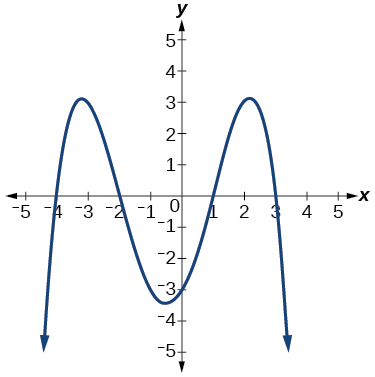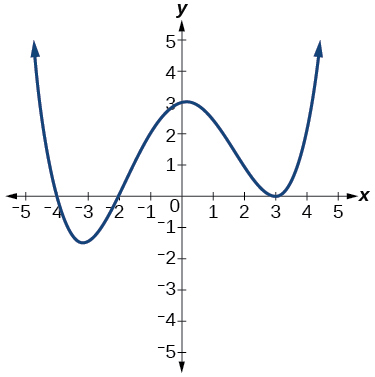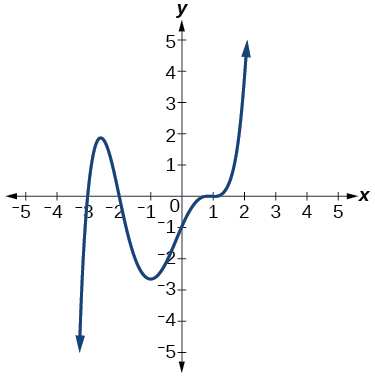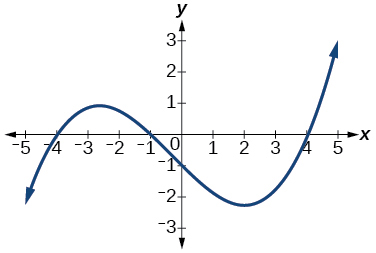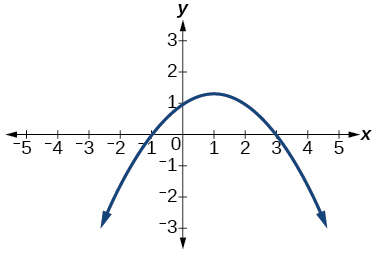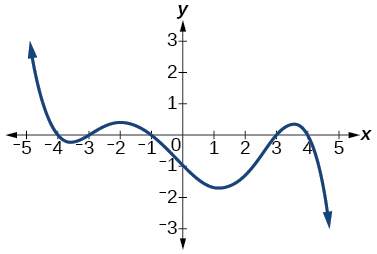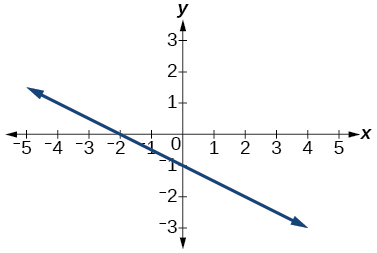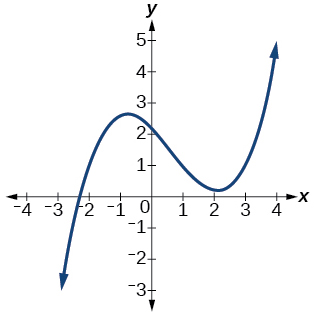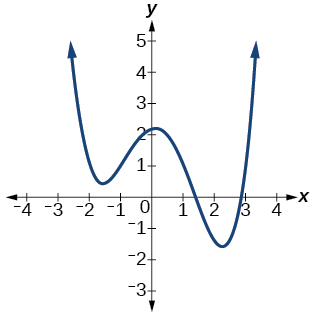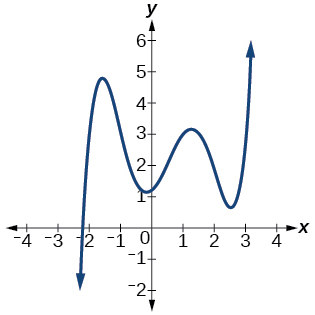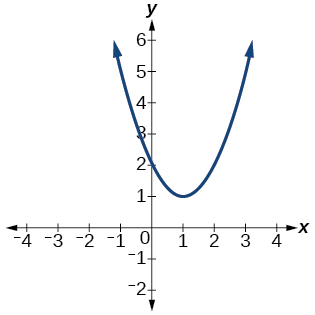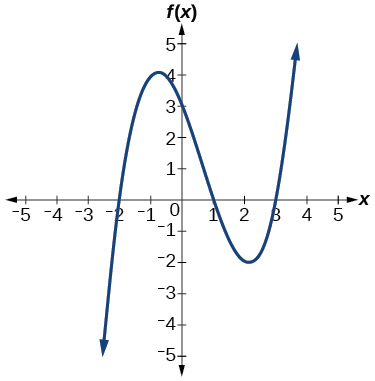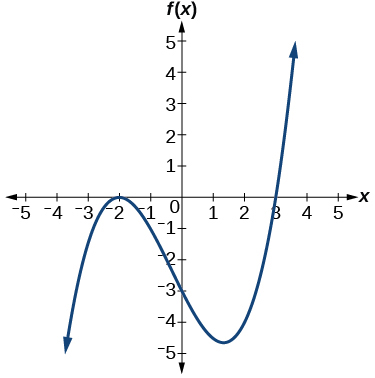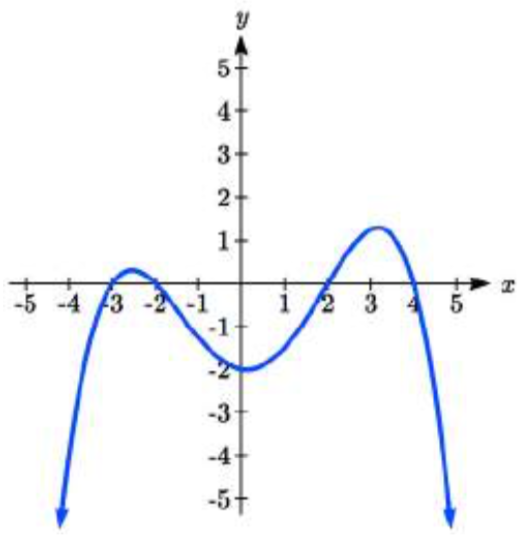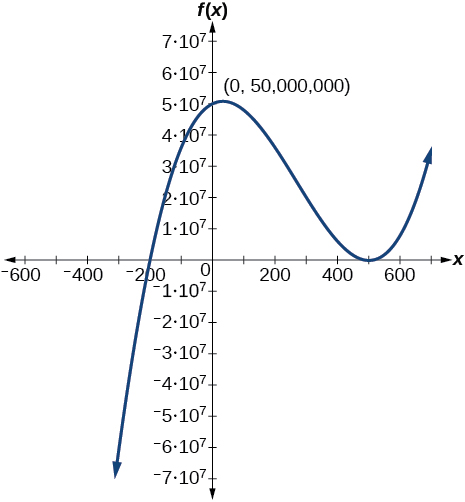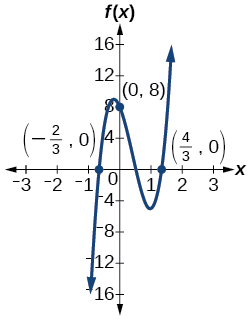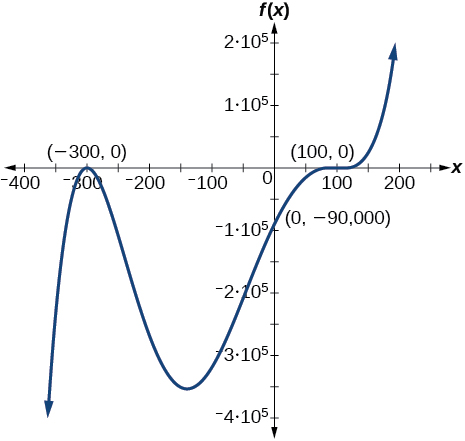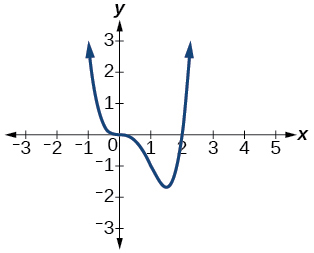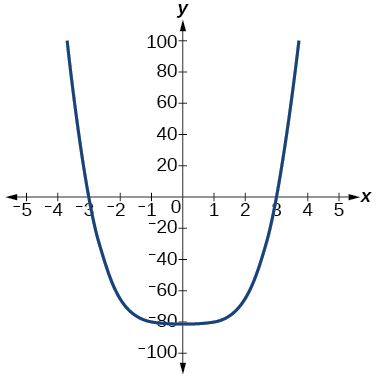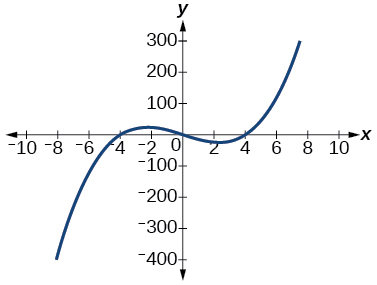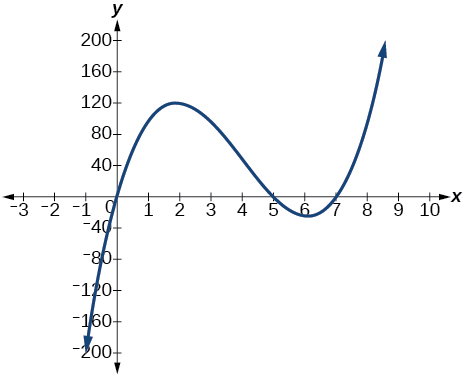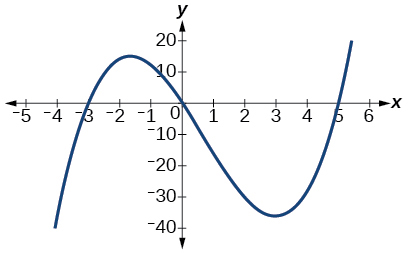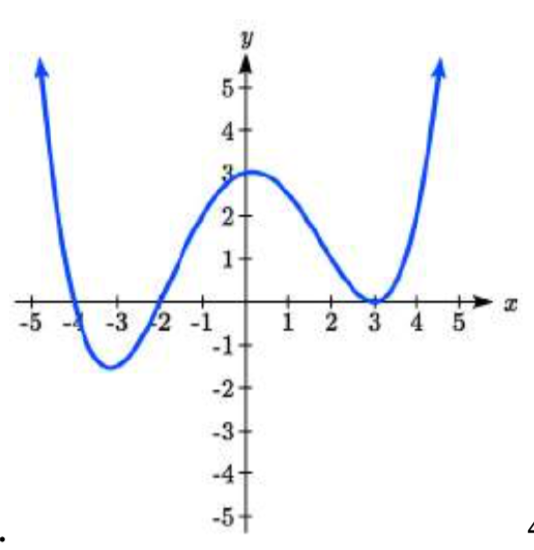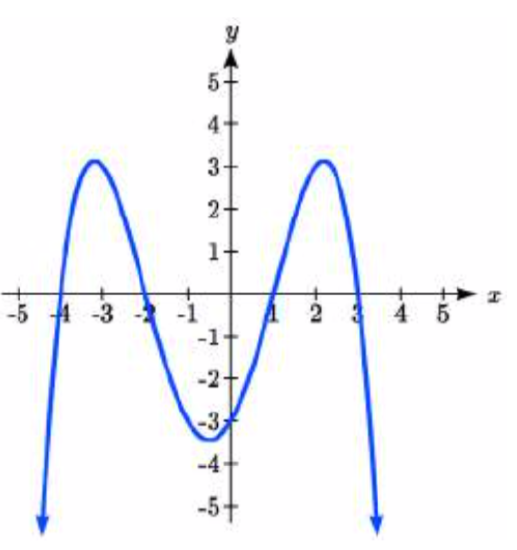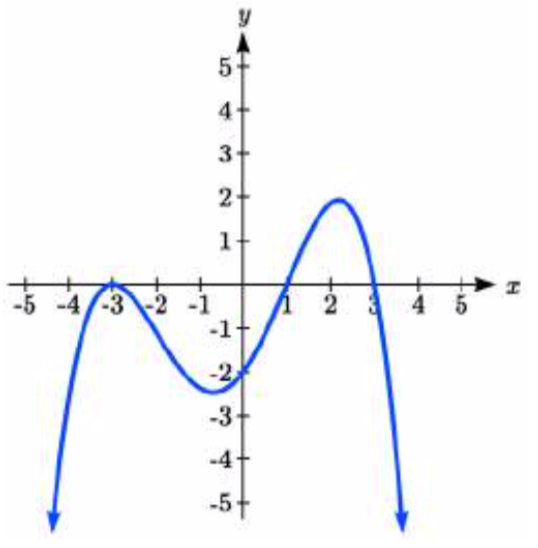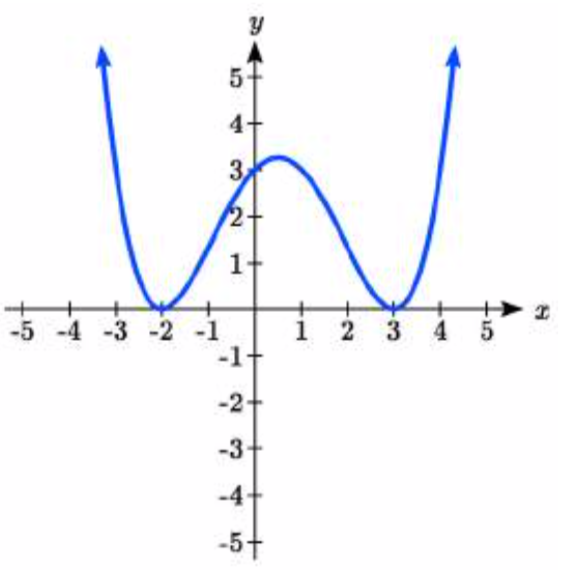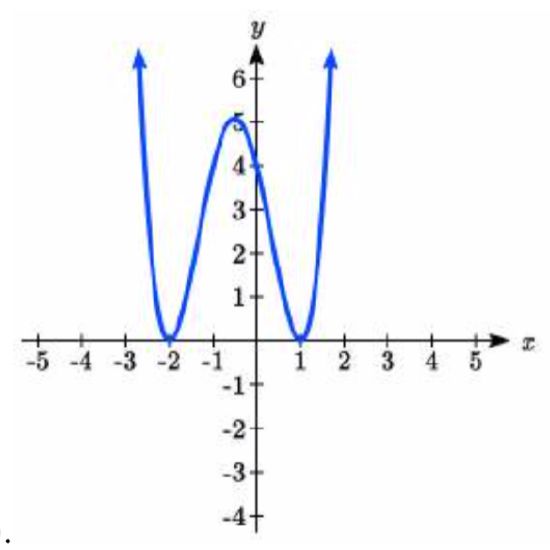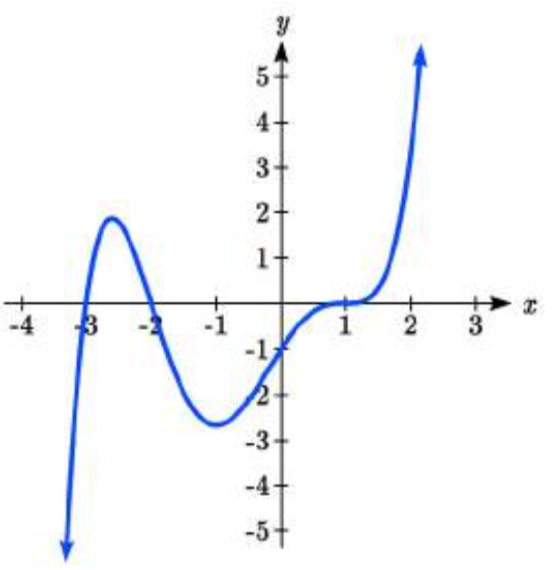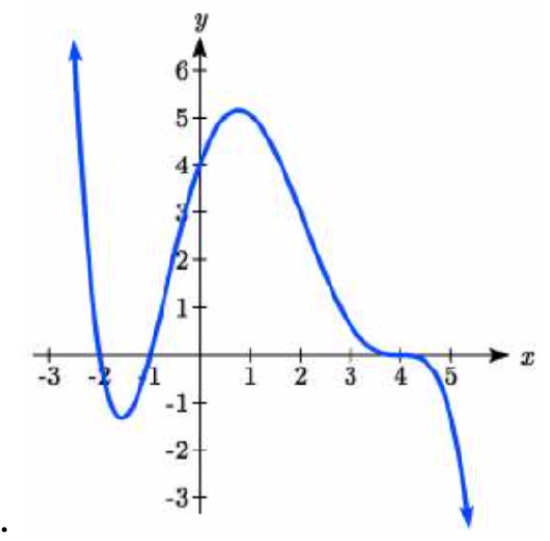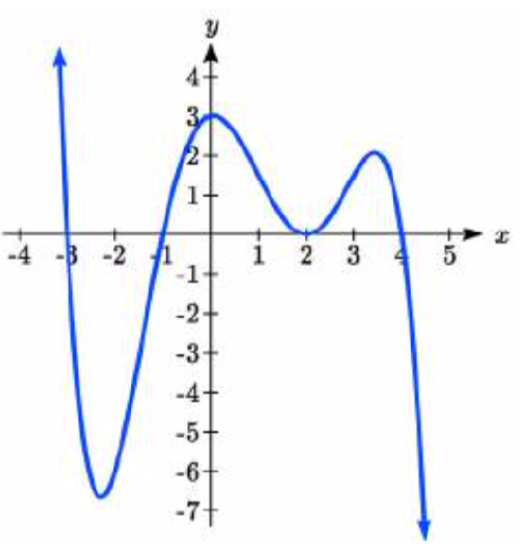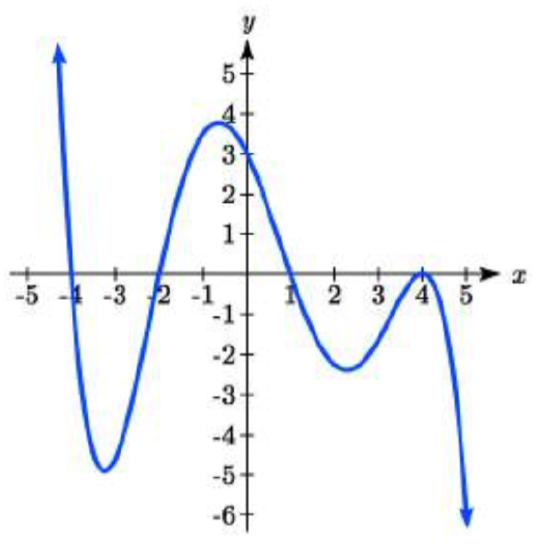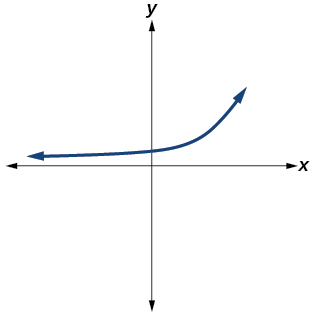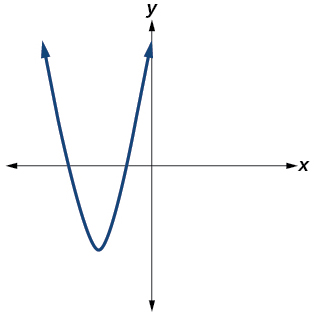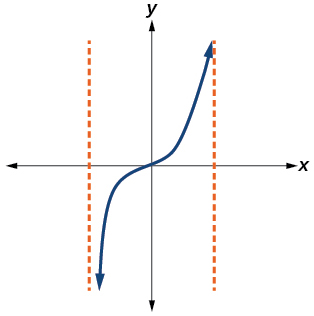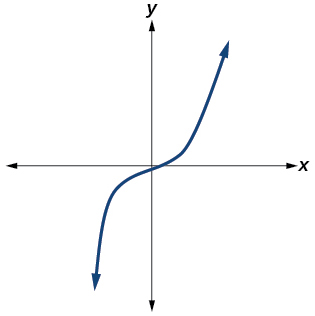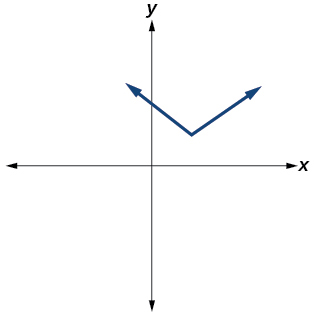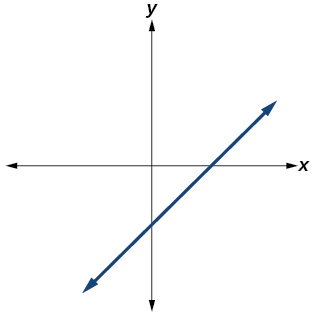3.4e: Exercises - Polynomial Graphs
- Page ID
- 45428
A: Concepts
Exercise \(\PageIndex{A}\)
1) What is the difference between an \(x\)-intercept and a zero of a polynomial function \(f\)?
2) If a polynomial function of degree \(n\) has \(n\) distinct zeros, what do you know about the graph of the function?
3) What is the relationship between the degree of a polynomial function and the maximum number of turning points in its graph? .
4) Explain how the factored form of the polynomial helps us in graphing it.
5) If the graph of a polynomial just touches the \(x\)-axis and then changes direction, what can we conclude about the factored form of the polynomial?
- Answers to odd exercises:
-
1. The \(x\)-intercept is where the graph of the function crosses the \(x\)-axis, and the zero of the function is the input value for which \(f(x)=0\).
3. The maximum number of turning points is one less than the degree of the polynomial.
5. There will be a factor raised to an even power.
B: Multiplicity from an Equation
Exercise \(\PageIndex{B}\)
\( \bigstar \) Find the zeros and give the multiplicity of each.
|
6) \(f(x)=(x+2)^3(x−3)^2\) 7) \(f(x)=x^2(2x+3)^5(x−4)^2\) 8) \(f(x)=x^3(x−1)^3(x+2)\) 9) \(f(x)=x^2(x^2+4x+4)\) 10) \(f(x)=(2x+1)^3(9x^2−6x+1)\) 11) \(f(x)=(3x+2)^5(x^2−10x+25)\) |
12) \(f(x)=x(4x^2−12x+9)(x^2+8x+16)\) 13) \(f(x)=x^6−x^5−2x^4\) 14) \(f(x)=3x^4+6x^3+3x^2\) 15) \(f(x)=4x^5−12x^4+9x^3\) 16) \(f(x)=2x^4(x^3−4x^2+4x)\) 17) \(f(x)=4x^4(9x^4−12x^3+4x^2)\) |
- Answers to odd exercises:
-
7. \(0\) and \(4\) with multiplicity \(2\), \(−\dfrac{3}{2}\) with multiplicity \(5\)
9. \(0\) with multiplicity \(2\), \(-2\) with multiplicity \(2\)
11. \(−\dfrac{2}{3}\) with multiplicity \(5\), \(5\) with multiplicity \(2\)
13. \(0\) with multiplicity \(4\), \(2\) and \(-1\) with multiplicity \(1\)
15. \(\dfrac{3}{2}\) with multiplicity \(2\), \(0\) with multiplicity \(3\)
17. \(0\) with multiplicity \(6\), \(\dfrac{2}{3}\) with multiplicity \(2\)
C: Multiplicity from a Graph
Exercise \(\PageIndex{C}\)
\( \bigstar \) Use the graph to identify zeros and multiplicity.
|
19)
|
20)
|
21)
|
22)
|
- Answers to odd exercises:
-
19. \(–4, –2, 1, 3\) with multiplicity \(1\)
21. \(–2, 3\) each with multiplicity \(2\)
D: Graph polynomials
Exercise \(\PageIndex{D}\)
\( \bigstar \) Graph the polynomial functions. State the \(x\)- and \(y\)- intercepts, multiplicity, and end behavior.
|
24) \(f(x)=(x+3)^2(x−2)\) 25) \(g(x)=(x+4)(x−1)^2\) 26) \(h(x)=(x−1)^3(x+3)^2\) 27) \(k(x)=(x−3)^3(x−2)^2 \) 28) \(m(x)=−2x(x−1)(x+3)\) |
29) \(n(x)=−3x(x+2)(x−4)\) 30. \(a(x) = x(x + 2)^{2}\) 31. \(g(x) = x(x + 2)^{3}\) 32. \(f(x) = -2(x-2)^2(x+1)\) 33. \(g(x) = (2x+1)^2(x-3)\) 34. \(f(x) = x^{3}(x + 2)^{2}\) |
35. \(P(x) = (x - 1)(x - 2)(x - 3)(x - 4)\) 36. \(q(x) = (x + 5)^{2}(x - 3)^{4}\) 37. \(h(x) = x^2(x-2)^2(x+2)^2\) 38. \(h(t) = (3-t)(t^2+1)\) 39. \(Z(b) = b(42 - b^{2})\) |
- Answers to odd exercises:
-
25. \(x\)-intercepts, \((1, 0)\) with multiplicity \(2\), \((–4, 0)\) with multiplicity \(1\), \(y\)- intercept \((0, 4)\) . As \(x→−∞\), \(f(x)→−∞\), as \(x→∞,\) \(f(x)→∞\).
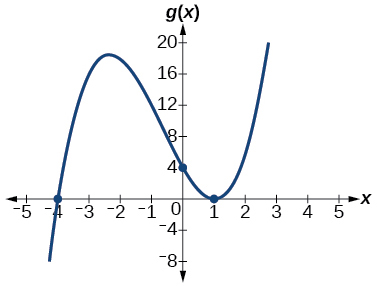
27. \(x\)-intercepts \((3,0)\) with multiplicity \(3\), \((2,0)\) with multiplicity \(2\), \(y\)- intercept \((0,–108).\) As \(x→−∞,\) \(f(x)→−∞\), as \(x→∞,\) \(f(x)→∞\).
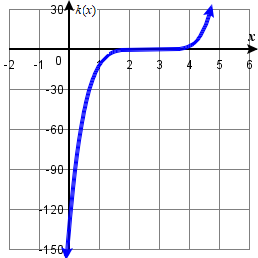
29. \(x\)-intercepts \((0, 0),(–2, 0),(4, 0)\) with multiplicity \(1\), \(y\)-intercept (0, 0). As \(x→−∞,\) \(f(x)→∞\), as \(x→∞,\) \(f(x)→−∞\).
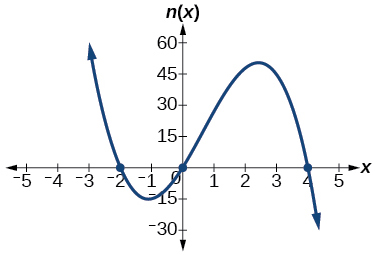
31. \( (-2,0) \) multiplicity \(3\),
\((0,0)\) multiplicity 1,
y-intercept \((0 ,0 )\),
end behaviour: \( \nwarrow \dots \nearrow \)
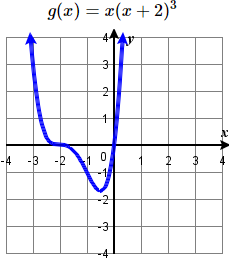
33. \((-\frac{1}{2} ,0 )\) multiplicity \(2\),
\((3 ,0 )\) multiplicity \(1\),
y-intercept \((0 ,-3 )\),
end behaviour: \( \swarrow \dots \nearrow \)
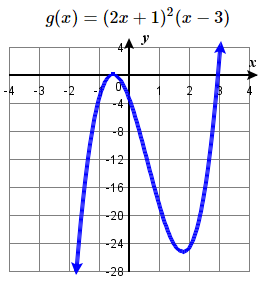
35. \((1 ,0 )\), \((2 ,0 )\), \((3 ,0 )\), \((4 ,0 )\)
all multiplicity \(1\),
y-intercept \((0 , 24)\),
end behaviour: \( \nwarrow \dots \nearrow \)
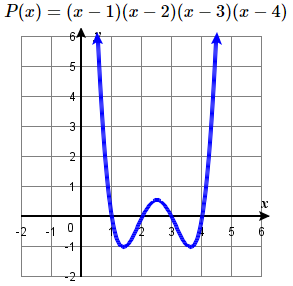
37. \((-2 ,0 )\), \((2 ,0 )\), \((0 ,0 )\)
all multiplicity \(2\), y-intercept \((0 ,0 )\),
end behaviour: \( \nwarrow \dots \nearrow \)
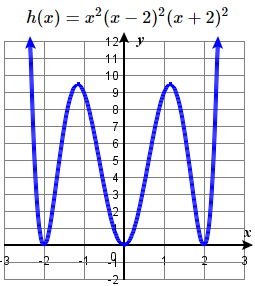
39. \((\sqrt{42} ,0 )\), \((-\sqrt{42} ,0 )\), \((0 ,0 )\)
all multiplicity \(1\), y-intercept \((0 ,0 )\),
end behaviour: \( \nwarrow \dots \searrow \)
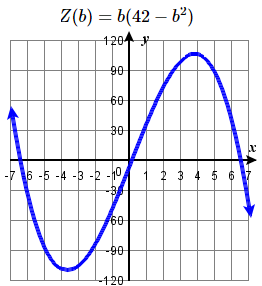
\( \bigstar \) Graph the polynomial functions. State the \(x\)- and \(y\)- intercepts, multiplicity, and end behavior.
|
41. \(f\left(x\right)=\left(x+3\right)^{2} (x-2)\) 42. \(g\left(x\right)=\left(x+4\right)\left(x-1\right)^{2}\) 43. \(h\left(x\right)=\left(x-1\right)^{3} \left(x+3\right)^{2}\) 44. \(k\left(x\right)=\left(x-3\right)^{3} \left(x-2\right)^{2}\) 45. \(m\left(x\right)=-2x\left(x-1\right)(x+3)\) |
46. \(n\left(x\right)=-3x\left(x+2\right)(x-4)\) 47. \(f(x) = 9x - x^3\) 48. \(f(x) =8 + x^3 \) 49. \(f(x) = x^4 - 25x^2\) 50. \( f(x) =16 - x^4 \) |
51. \(f(x) = -x^4 + 2x^3 + 8x^2\) 52. \(f(x) =x^3+7x^2 -9x \) 53. \(f(x) = 2x^3 + 12x^2 - 8x - 48\) 54. \(f(x) = 4x^4 + 10x^3 - 4x^2 -10x \) |
- Answers to odd exercises:
-
41. \((-3 ,0 )\) multiplicity \(2\),
\((2 ,0 )\) multiplicity \(1\),
y-intercept\((0 ,-18 )\), \( \swarrow \dots \nearrow \)
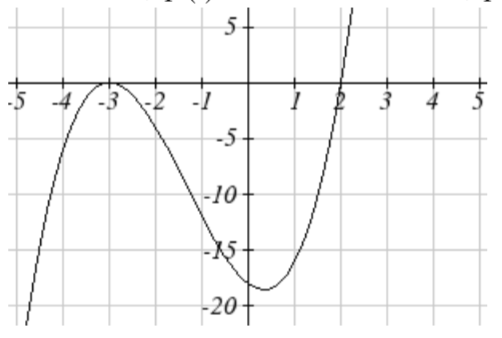
43. \(( -3, 0)\) multiplicity \(2\),
\((1 , 0) \) multiplicity \(3\),
y-intercept\(( 0, -9)\), \( \swarrow \dots \nearrow \)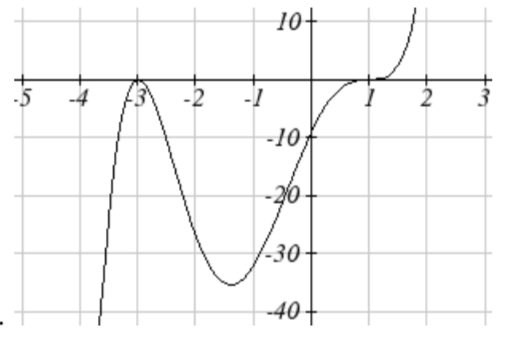
45. \((-3 , 0)\), \((0 , 0)\), \((1 , 0)\)
all multiplicity \(1\),
y-intercept\((0 ,0 )\), \( \nwarrow \dots \searrow \)
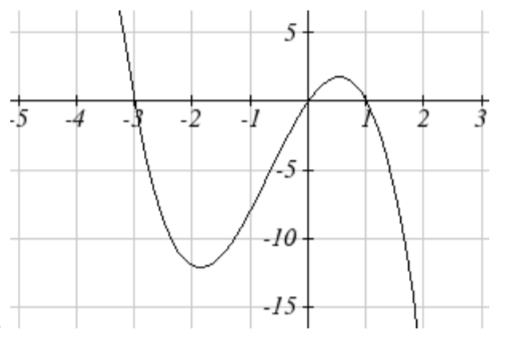
47. \((-3 , 0)\), \((0 , 0)\), \((3 , 0)\)
all multiplicity \(1\),
y-intercept \((0 ,0 )\), \( \nwarrow \dots \searrow \)
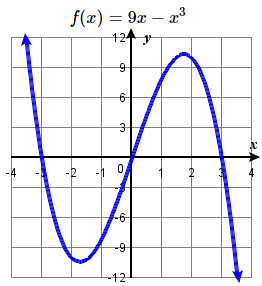
49. \(( -5, 0) \), \(( 5, 0) \) both multiplicity \(1\),
\((0 , 0)\) multiplicity \(2\),
y-intercept \((0 ,0 )\), \( \nwarrow \dots \nearrow \)
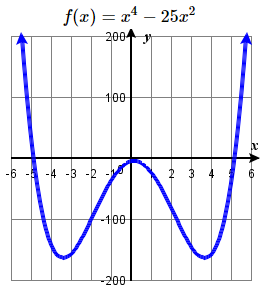
51. \(( -2, 0)\), \(( 4, 0)\) both multiplicity \(1\),
\((0 , 0)\) multiplicity \(2\),
y-intercept \((0 ,0 )\), \( \swarrow \dots \searrow \)
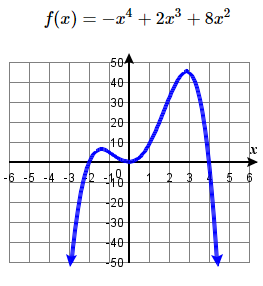
53. \((-6 , 0)\), \((-2 , 0)\), \((2 , 0)\)
all multiplicity \(1\),
y-intercept \((0 , -48)\), \( \swarrow \dots \nearrow \)
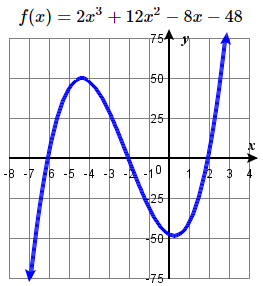
E: Polynomial Degree from a Graph
Exercise \(\PageIndex{E}\)
\( \bigstar \) Determine the least possible degree of the polynomial function shown.
|
61)
|
62)
|
63)
|
64)
|
|
65)
|
66)
|
67)
|
68)
|
- Answers to odd exercises:
-
61. \(3\), \(\qquad\) 63. \(5\), \(\qquad\) 65. \(3\), \(\qquad\) 67. \(5\)
F: Construct an Equation from a graph
Exercise \(\PageIndex{F}\)
\( \bigstar \) Use the graphs to write the formula for the polynomial function of least degree.
|
69)
|
70)
|
71)
|
|
72)
|
73.
|
74) 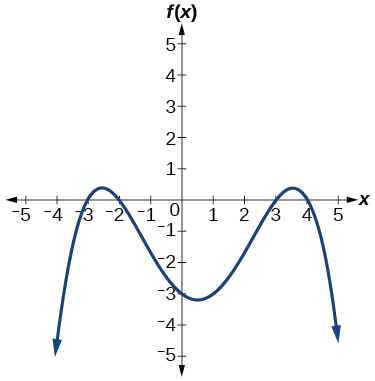 |
- Answers to odd exercises:
-
69. \( f(x) = -(x+3)(x+1)(x-3)\) or \( f(x) = -\frac{2}{9}(x+3)(x+1)(x-3)\)
71. \( f(x) = (x+2)^2(x-3)\) or \( f(x) = \frac{1}{4}(x+2)^2(x-3)\)
73. \( f(x) = -(x+3)(x+2)(x-2)(x-4) \) or \( f(x) = -\frac{1}{24}(x+3)(x+2)(x-2)(x-4) \) -
\( \bigstar \) Use the graphs to write a formula for the polynomial function of least degree.
|
75)
|
76)
|
77)
|
78)
|
|
79)
|
80)
|
81)
|
82)
|
- Answers to odd exercises:
-
75. \(f(x)=(x−500)^2(x+200)\) 77. \(f(x)=(x+300)^2(x-100)^3\)
79. \(f(x)=(x+3)(x-3)(x^2+10)\) 81. \(f(x)=4x(x-5)(x-7)\)
\( \bigstar \) Use the graphs to write a formula for the polynomial function of least degree.
|
83.
|
84(a).
|
84(b).
|
|
85.
|
86.
|
87.
|
|
88.
|
89. . |
90.
|
- Answers to odd exercises:
-
83. \(y = \dfrac{1}{24} (x + 4) (x + 2) (x - 3)^2\)
85. \(y = \dfrac{1}{12} (x + 2)^2 (x - 3)^2\)
87. \(y = \dfrac{1}{6} (x + 3) (x + 2) (x - 1)^3\)
89. \(y = -\dfrac{1}{16} (x + 3)(x + 1) (x - 2)^2 (x - 4)\)
G: Construct an Equation from a Description
Exercise \(\PageIndex{G}\)
\( \bigstar \) Use the information about the graph of a polynomial function to determine the function. Assume the leading coefficient is \(1\) or \(-1\). There may be more than one correct answer.
91) The \(y\)-intercept is \((0,−4)\). The \(x\)-intercepts are \((−2,0), (2,0)\). Degree is \(2\). End behavior: \( \nwarrow \dots \nearrow \)
92) The \(y\)-intercept is \((0,9)\). The \(x\)-intercepts are \((−3,0), (3,0)\). Degree is \(2\). End behavior: \( \swarrow \dots \searrow \)
93) The \(y\)-intercept is \((0,0)\). The \(x\)-intercepts are \((0,0), (2,0)\). Degree is \(3\). End behavior: \( \swarrow \dots \searrow \)
94) The \(y\)-intercept is \((0,1)\). The x-intercept is \((1,0)\). Degree is \(3\). End behavior: \( \nwarrow \dots \searrow \)
95) The \(y\)-intercept is \((0,1)\). There is no \(x\)-intercept. Degree is \(4\). End behavior: \( \nwarrow \dots \nearrow \)
\( \bigstar \) Use the given information about the polynomial graph to write the equation.
97) Degree \(3\). Zeros at \(x=–2\),\(x=1\), and \(x=3\). \(y\)-intercept at \((0,–4)\)
98) Degree \(3\). Zeros at \(x=–5\), \(x=–2\), and \(x=1\). \(y\)-intercept at \((0,6)\)
99) Degree \(5\). Roots of multiplicity \(2\) at \(x=3\) and \(x=1\). Root of multiplicity \(1\) at \(x=–3\).
\(\quad\)\(y\)-intercept at \((0,9)\)
100) Degree \(4\). Root of multiplicity \(2\) at \(x=4\). Roots of multiplicity \(1\) at \(x=1\) and \(x=–2\).
\(\quad\)\(y\)-intercept at \((0,–3)\)
101) Degree \(5\). Double zero at \(x=1\). Triple zero at \(x=3\). Passes through the point \((2,15)\)
102) Degree \(3\). Zeros at \(x=4\), \(x=3\), and \(x=2\). \(y\)-intercept at \((0,−24)\)
103) Degree \(3\). Zeros at \(x=−3\), \(x=−2\) and \(x=1\). \(y\)-intercept at \((0,12)\)
104) Degree \(5\). Roots of multiplicity \(2\) at \(x=−3\) and \(x=2\). Root of multiplicity \(1\) at \(x=−2\). \(y\)-intercept at \((0, 4)\).
105) Degree \(4\). Roots of multiplicity \(2\) at \(x=\dfrac{1}{2}\). Roots of multiplicity \(1\) at \(x=6 \) and \(x=−2\). \(y\)-intercept at \((0,18)\)
106) Double zero at \(x=−3\). Triple zero at \(x=0\). Passes through the point \((1,32)\).
107. Degree 3. Zeros at \(x\) = -2, \(x\) = 1, and \(x\) = 3. Vertical intercept at (0, -4)
108. Degree 3. Zeros at \(x\) = -5, \(x\) = -2, and \(x\) = 1. Vertical intercept at (0, 6)
109. Degree 5. Roots of multiplicity 2 at \(x\) = 3 and \(x\) = 1. Root of multiplicity 1 at \(x\) = -3. Vertical intercept at (0, 9)
110. Degree 4. Root of multiplicity 2 at \(x\) = 4. Roots of multiplicity 1 at \(x\) = 1 and \(x\) = -2.
\(\quad\)Vertical intercept at (0, -3)
111. Degree 5. Double zero at \(x\) = 1. Triple zero at \(x\) = 3. Passes through the point (2, 15)
112. Degree 5. Single zero at \(x\) = -2 and \(x\) = 3. Triple zero at \(x\) = 1. Passes through the point (2, 4)
- Answers to odd exercises:
-
91. \(f(x)=x^2−4\)
93. \(f(x)=x^3−4x^2+4x\)
95. \(f(x)=x^4+1\)
97. \(f(x)=−\dfrac{2}{3}(x+2)(x−1)(x−3)\)
99. \(f(x)=\dfrac{1}{3}(x−3)^2(x−1)^2(x+3)\)
101. \( f(x) =−15(x−1)^2(x−3)^3\)
103. (f(x)=−2(x+3)(x+2)(x−1)\)
105. \(f(x)=−\dfrac{3}{2}(2x−1)^2(x−6)(x+2)\)
107. \(y = -\dfrac{2}{3} (x + 2) (x - 1) (x - 3)\)
109. \(y = \dfrac{1}{3} (x - 1)^2 (x - 3)^2 (x + 3)\)
111. \(y = -15(x - 1)^2 (x - 3)^3\)
H: Turning Points
Exercise \(\PageIndex{H}\)
\( \bigstar \) Determine whether the graph of the function provided is a graph of a polynomial function. If so, determine the number of turning points and the least possible degree for the function.
|
115)
|
116)
|
117)
|
118)
|
|
119)
|
120)
|
121)
|
|
- Answers to odd exercises:
-
115. Yes. Number of turning points is \(2\). Least possible degree is \(3\).
117. Yes. Number of turning points is \(1\). Least possible degree is \(2\).
119. Yes. Number of turning points is \(0\). Least possible degree is \(1\).
212. Yes. Number of turning points is \(0\). Least possible degree is \(1\).
\( \star \)


